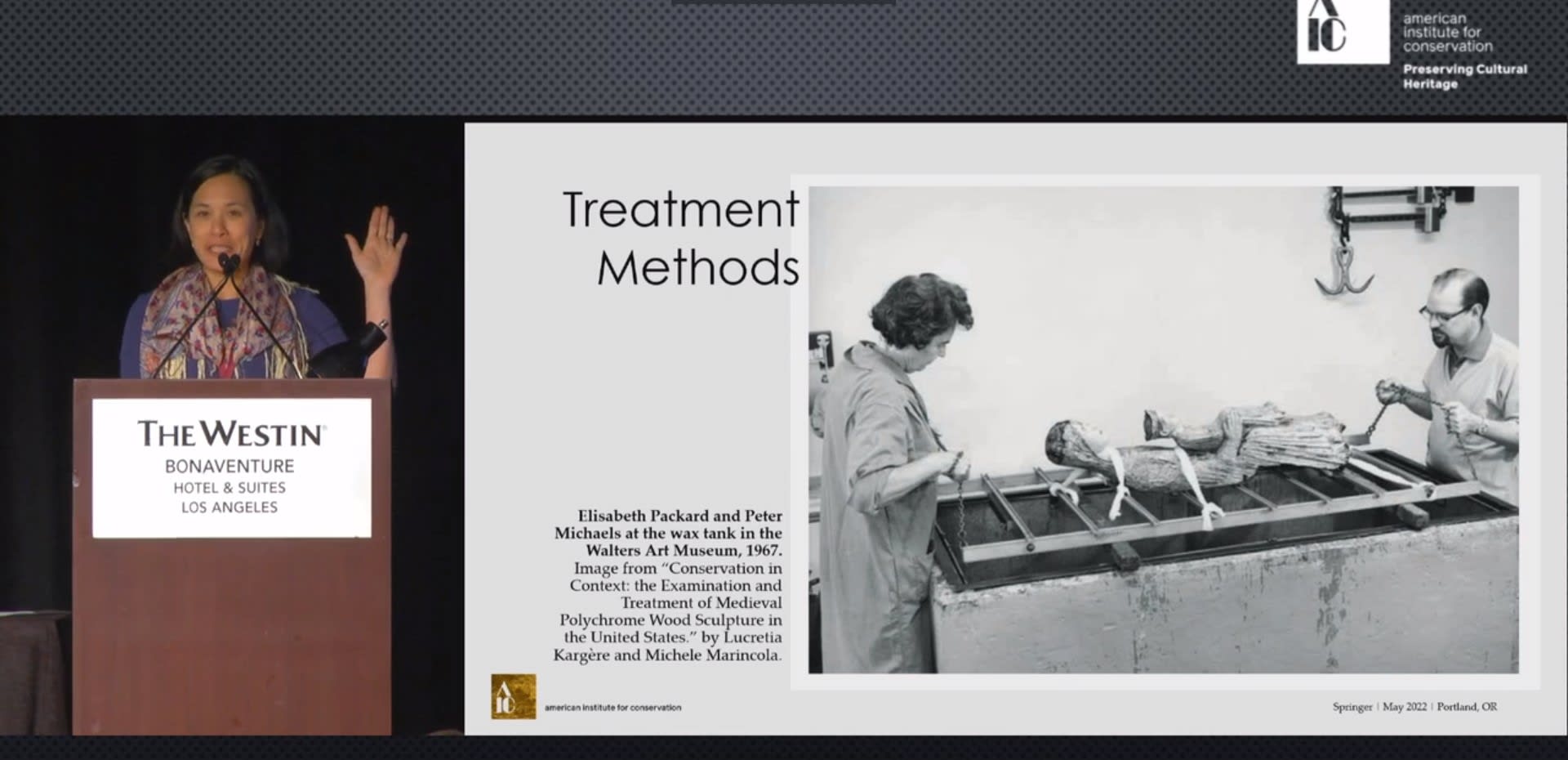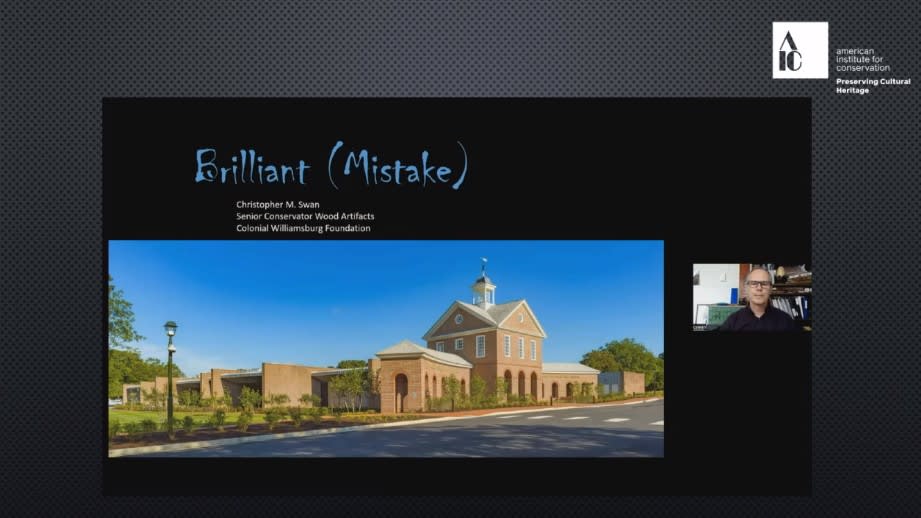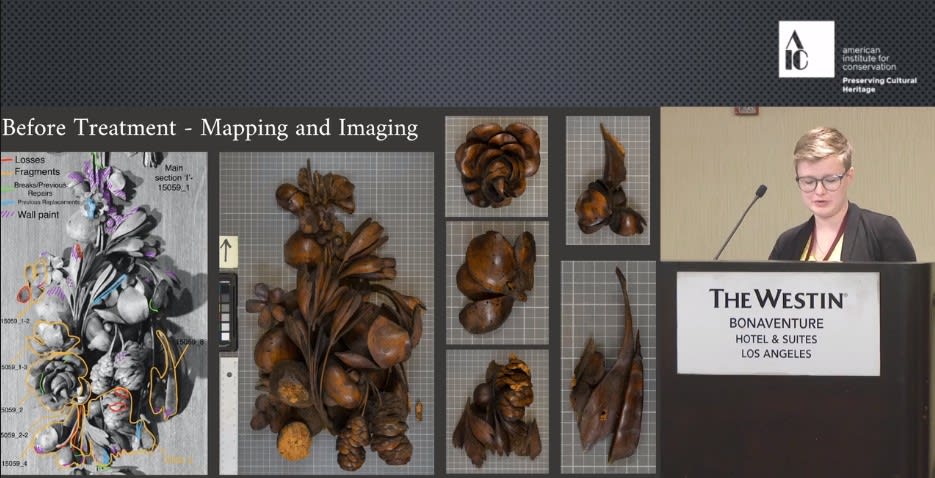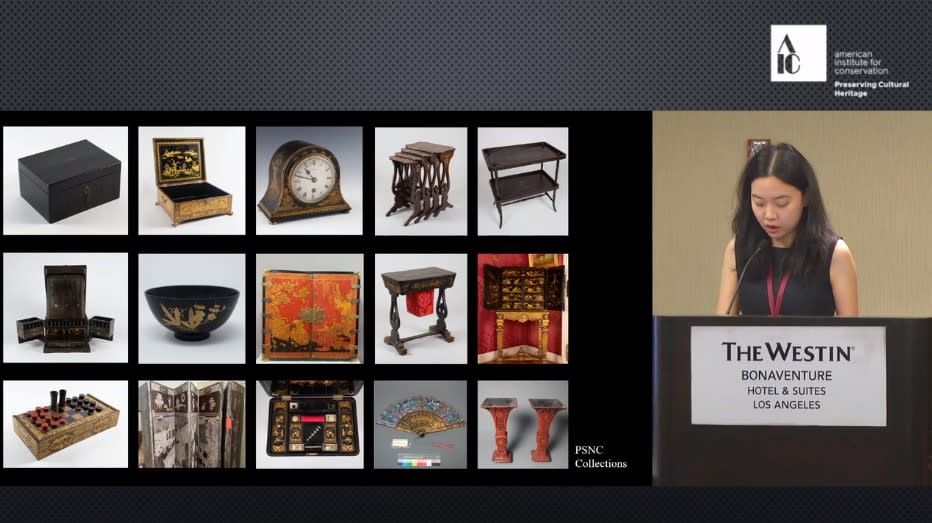Perrine Lesaux, Assistant Conservator of Paper, Kirsten Moffitt, Conservator & Materials Analyst, Shelley Svoboda, Senior Paintings Conservator, Chris Swan, Senior Wooden Artifacts Conservator, Sarah Towers, Assistant Conservator of Wooden Artifacts and Upholstery, and Pam Young, Senior Paper Conservator attended the American Institute for Conservation’s 50th Annual Meeting’s Virtual conference. It was “live” May 13-17, 2022 with virtual content available through October 31, 2022.
This professional development opportunity was made possible by Colonial Williamsburg’s Gonzales Field Experience Fund.

This six-day conference brought together hundreds of conservators from the US and overseas in a gathering representing the latest papers, workshops, and academic posters in the field of cultural heritage conservation under the banner of the American Institute of Conservation (AIC). AIC is the professional organization for US-based conservators of cultural heritage and hosts this conference in a different city annually. Attending the Annual Meeting allows professional conservators to maintain active professional development, grow networks, and engage in the latest research. This year’s Annual Meeting was held in person in Los Angeles, with more attending virtually through live-streamed sessions. This year, six Foundation conservators attended the virtual component, a fantastic opportunity to tune in to a wide range of presentations pertinent to our work.
The Annual Meeting always has a focused theme for speakers and attendees to consider, and this year’s, in celebration of the 50th anniversary of the Annual Meeting, was “Reflecting on the Past, Imagining the Future.” Many of the presentations dealt with historic conservation topics; older materials, techniques, or approaches that we have set aside in favor of evolved technologies, but examined anew in thought-provoking ways. It also culminated in a noteworthy session reflecting on 50 years of AIC History (Image 2). This session featured lightning-round presentations representing every specialty within conservation, which was a fascinating glimpse into the evolution of contemporary conservation practices, and gave younger conservators insight into how the field has grown and changed.

Especially relevant for us here at CWF, with our focus on colonial American history, were several contemplative, self-reflective talks on colonialist themes in historical archaeology and art history. One such presentation by Caitlin O’Grady explored the colonial origins of archaeology, especially the archaeology of ancient Egyptian sites in the 1920s. This talk challenged today’s conservators to be more intentional and inclusive in considering how indigenous communities participate in and contribute to the field. Similarly, Dr. Narayan Khandekar presented a powerful lecture “On the Use of Culturally Appropriate Technical Terminology” which exposed how Italian art historical terms have dominated western rhetoric of all art across the globe, often without consideration for an artist’s preferred terminology. This was another eye-opening talk, and a reminder to consider the power of language.
A crowd favorite was the “Mistakes Session”, where participants are invited to share professional mistakes, with the belief that candid self-reflection benefits the field overall. One of our own, Senior Furniture Conservator Chris Swan, gave a short presentation on a well-intentioned but ultimately unsuccessful repair of a North Carolina dresser attributed to the Jacob Sanders Shop (#1936-34) which presented a contemplative look at an older treatment (Image 3). Participant Perrine Lesaux noted that the Mistakes Session “helped with personal self-reflection and will influence my approach to future treatments and projects”.

There were also many specialty sessions, which focused on materials-specific projects or research in different categories such as paper, textiles, wood, or paintings. These covered specific techniques or innovations which we can apply to our daily work. Here are some highlights from participating labs on their favorite sessions:
Paper Conservation Lab:
- “There was one lunch panel discussion […] that was helpful to me regarding the treatment of varnished 19th-century maps. This informed my treatment decisions on the treatment of the Price Strother map of North Carolina (#2012-148).” – Perrine Lesaux
Wooden Artifacts Conservation Lab:
- “In a presentation of a carved overmantel by well-known carver Grinling Gibbons (Image 4), I learned about a technique for graduated consolidation of pest damage in wood, which was new to me and which I will develop in future treatments.
- A paper on classical Chinese gilding techniques demonstrated materials and processes which are very different from what we typically see in CWF’s collection. However, they were so informative to compare against our current project treating the Robert Davis japanned High Chest (#1959-100), japanning being a western adaptation of Japanese and Chinese lacquer and gilding methods.
- Similarly, a presentation on a lacquerware survey at the Preservation Society of Newport (Image 5) was a fascinating glimpse into how a similar institution grapples with its lacquerware collection. It was helpful to hear how they surveyed and defined lacquerware, and created outlines for future recommendations. This paper shared helpful guidelines which I will use in our next large-scale survey.” – Sarah Towers

Materials Analysis Lab:
- “Thanks to my attendance at the virtual AIC 2022 meeting I was able to hear multiple lectures on new and promising technologies such as LIBS (laser-induced breakdown spectroscopy) and how it is being used by conservation scientists to identify various cultural heritage materials, even, in some cases, to identify specific wood species from one another.
- The RATS [Research and Technical Studies]/Wooden artifacts session featured several fascinating presentations on the analysis and conservation of Asian lacquerware, and a lecture on traditional gilding techniques at the Forbidden City in China contributed greatly to my knowledge of finishes of that period. These lectures and more have had a positive impact on my work in the analytical lab at CW, allowing me to share with colleagues the most current research and new technologies and their application to museum objects.” -Kirsten Moffitt

Paintings Conservation Lab:
- “[I] found two talks of particular interest: ‘A Step at a Time: Reconsidering the Look of Charles Willson Peale’s 1795 Staircase Group’ by Lucia Bay and ‘Projection Meets Perspective: Study on the Development of Chinese-European Painting Artworks in Imperial Court by Non-invasive Analysis’ by Yong Lei and Guanghua Li at The Palace Museum, Beijing, China. With the ten paintings in the Foundation’s collections by artist CW Peale, this talk on Peale’s Staircase Group is very constructive. The presentation on Chinese-European paintings was of interest both for the diverse application of non-destructive testing approaches and specific results identifying organic pigments such as indigo - one of the compounds my research has focused on.” – Shelley Svoboda
We are grateful to the Mary and Donald Gonzales Field Experience Fund Committee for their support of this professional development experience.
Sarah Towers is an Assistant Conservator of Wooden Artifacts and Upholstery at the Foundation. Her research interests focus on composite wooden objects including musical instruments, upholstered furniture, and gilded surfaces.
Colonial Williamsburg is the largest living history museum in the world. Witness history brought to life on the charming streets of the colonial capital and explore our newly expanded and updated Art Museums of Colonial Williamsburg, featuring the nation’s premier folk art collection, plus the best in British and American fine and decorative arts from 1670–1840. Check out sales and special offers and our Official Colonial Williamsburg Hotels to plan your visit.